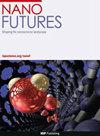光催化降解亚甲基蓝的g-C3N4/TiO2-ZnO纳米结构的合成与表征
IF 3.3
4区 材料科学
Q3 MATERIALS SCIENCE, MULTIDISCIPLINARY
引用次数: 3
摘要
在本研究中,合成了具有不同ZnO和TiO2摩尔比的石墨氮化碳(g-C3N4)纳米结构(即g-C3N4/TiO2、g-C3N4/ZnO和g-C3N4-TiO2-ZnO)。使用场发射扫描电子显微镜(FE-SEM)、x射线衍射、Brunauer–Emmett–Teller(BET)分析和紫外(UV)–可见漫反射光谱(UV-vis-DRS)技术对合成的样品进行了表征。FE-SEM图像显示了每个样品的表面形态。UV-vis-DRS结果表明,添加g-C3N4和不同摩尔比的ZnO可以降低TiO2的带隙。BET分析结果证实,g-C3N4/TiO2-ZnO(1:10)纳米结构的表面积为97.494 cm2 g−1,相对高于其他纳米结构,适合于光催化活性。通过在模拟太阳光下对亚甲基蓝(MB)染料的光降解,研究了g-C3N4/TiO2-ZnO纳米结构的光催化活性。光催化活性的结果表明,合成的纳米结构在紫外光和可见光照射下的降解率分别为94.6%和62.4%。此外,光催化降解动力学证实,在紫外光存在下,MB染料的降解速度快于可见光。此外,对纳米结构的可重复使用性的研究在六次运行后表现出良好的光稳定性和活性。本文章由计算机程序翻译,如有差异,请以英文原文为准。
Synthesis and characterization of a g-C3N4/TiO2-ZnO nanostructure for photocatalytic degradation of methylene blue
In this study, graphitic carbon nitride (g-C3N4) nanostructures with different molar ratios of ZnO and TiO2 (i.e. g-C3N4/TiO2, g-C3N4/ZnO, and g-C3N4/TiO2-ZnO) were synthesized. The synthesized samples were characterized using field-emission scanning electron microscopy (FE-SEM), x-ray diffraction, Brunauer–Emmett–Teller (BET) analysis, and ultraviolet (UV)–visible diffuse reflectance spectroscopy (UV-vis-DRS) techniques. The FE-SEM images showed the surface morphology of each sample. The UV-vis-DRS results indicated that the bandgap of TiO2 was reduced by adding g-C3N4 and different molar ratios of ZnO. The results obtained from BET analysis confirmed that the surface area of the g-C3N4/TiO2-ZnO (1:10) nanostructure was 97.494 cm2 g−1, which was comparatively higher than other nanostructures, and became suitable for photocatalytic activity. The photocatalytic activity of the g-C3N4/TiO2-ZnO nanostructure was performed by photo-degradation of methylene blue (MB) dye under simulated solar light. The results of the photocatalytic activity showed that the synthesized nanostructure had good degradation under UV and visible light irradiation by 94.6% and 62.4%, respectively. Also, the kinetics of the photocatalytic degradation confirmed that degradation of MB dye in the presence of UV light was faster than visible light. Furthermore, a study of the reusability of the nanostructure exhibited good photo-stability and activity after six runs.
求助全文
通过发布文献求助,成功后即可免费获取论文全文。
去求助
来源期刊

Nano Futures
Chemistry-General Chemistry
CiteScore
4.30
自引率
0.00%
发文量
35
期刊介绍:
Nano Futures mission is to reflect the diverse and multidisciplinary field of nanoscience and nanotechnology that now brings together researchers from across physics, chemistry, biomedicine, materials science, engineering and industry.
 求助内容:
求助内容: 应助结果提醒方式:
应助结果提醒方式:


